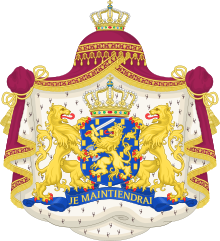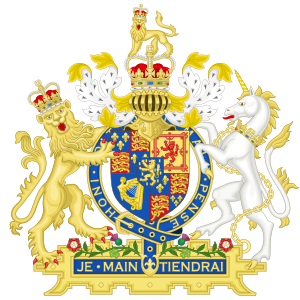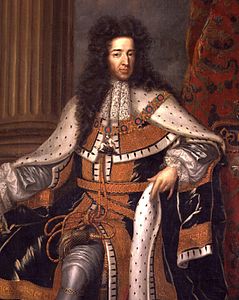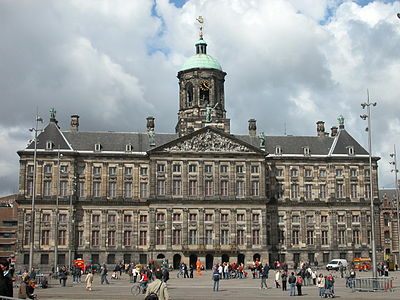House of Orange-Nassau

The House of Orange-Nassau ( Dutch Huis Oranje-Nassau ) is the ruling royal house of the Netherlands . His political supporters used to be called orangists .
Originally the name Orange comes from the Provencal county of Orange ( French Orange ), the later Principality of Orange in the Rhone plain in what is now France.
The ruling part of the House of Nassau in the Netherlands has also held the title of Prince of Orange (French Prince d'Orange , Dutch Prins van Oranje ) since 1530 . After another inheritance in 1702, both the House of Orange-Nassau and the House of Hohenzollern-Prussia held the title of Prince of Orange. The translation "Prince of Orange" is only correct for the historical (republican) governors of the Netherlands from the House of Orange-Nassau (until 1795), but the Principality of Orange (Orange, Orange) was lost to the Nassauers on April 11, 1713. The title "Prince of Orange" was confirmed by a treaty with the King of Prussia on June 16, 1732 and became sovereign Prince of the Netherlands on December 2, 1813 as William I and finally on March 16, 1815, King of the Netherlands and Duke (Grand Duke from June 9, 1815 to November 23, 1890) of Luxembourg was retained until today. Since August 24, 1815, according to the constitution of the Netherlands, the title of Prins van Oranje has traditionally been the title of Crown Prince of the Netherlands, who was always the eldest son of the king. Since a constitutional reform of February 17, 1983, the eldest child of the head of state has always been the heir to the throne, i.e. crown prince or crown princess, regardless of gender. Since May 20, 2002, the female form Prinses van Oranje has also been possible for a crown princess. This regulation came into force for the first time for Amalia van Oranje on April 30, 2013 .
Establishment of the House of Orange
The forecast for the city was orange in the southern French Département Vaucluse around the year 800 by a vassal Emperor Charlemagne named William ( Guilhem d'Orange ingested). Although he was the first Count of Orange, he was not a relative of the current Princes of Orange. This William of Orange is also associated with William of Toulouse (alias William of Aquitaine) and Saint-Guilhem (see Saint-Guilhem-le-Désert ).
principality
In 1163 the county was raised to the status of imperial principality by Emperor Friedrich I Barbarossa . The principality, barely 300 square kilometers in size, came to the Chalon family at the beginning of the 15th century through the families of Montpellier and Les Baux . The French King Francis I annexed the principality, and the last of the Chalon family, Philibert of Chalon , was imprisoned from 1524 to 1526. Philibert then took part in the Sacco di Roma as general of Emperor Charles V , later defended Naples against the French and got his principality back in 1529 as a reward. He died childless in 1530 at the age of 28.
House of Orange-Nassau
Philibert's sister Claudia von Chalon was with Heinrich III. von Nassau married (the Nassau already owned large parts of the Netherlands). The son of Claudias and Heinrich, Renatus , inherited the principality. Before Renatus died - without legal descendants - he named his cousin Wilhelm von Nassau-Dillenburg as heir, who was therefore allowed to call himself Prince of Orange. However, the condition of Emperor Charles V was that Wilhelm was brought up Catholic at his court in Brussels . Charles's son Philip II of Spain made him governor of the Seventeen Provinces . When the Calvinist Seven Provinces in the north rebelled against the blood regime of the Duke of Alba and the Inquisition in 1568 under the leadership of the Geuzen , Wilhelm took the lead. In 1581 the seven provinces declared their formal independence from Spain as the Republic of the Seven United Netherlands , with William of Orange as governor and the States General as parliament. The Eighty Years' War with Spain began . In 1584 a Catholic fanatic murdered Wilhelm in Delft . His son Moritz followed him as army leader and governor. The construction of a hereditary governorship, instead of a monarchy, led to a generation-long rivalry between the oligarchically ruling patricians of the wealthy trading cities, especially the rulers of Amsterdam , and the popular governor dynasty - during the entire Golden Age and even the 18th century. Century. The War of Independence with Spain was only ended in 1648 with the Peace of Westphalia , which brought international recognition to the Republic of the United Netherlands and, at the same time, its departure from the Holy Roman Empire .
William III. from England
Wilhelm's great-grandson, the governor Wilhelm III. von Orange , lived in the Huis ten Bosch in The Hague and had Het Loo Castle built as a summer residence. Together with his wife Maria II from the House of Stuart, he ascended the English throne in 1688. He saw his main task in curbing the hegemonic claims of the French "sun king" Louis XIV , which involved the Netherlands in decades of war. When he died childless in 1702, the line of Wilhelm I expired and the governorship of the Netherlands was suspended.
King Wilhelm III.
Succession of the House of Nassau-Diez
The king had appointed his cousin Johann Wilhelm Friso von Nassau-Diez († 1711) as the sole heir, who was descended from a brother of Wilhelm I and had been captain general of Friesland from 1707 and governor of Groningen from 1708. However, the King of Prussia , Friedrich I , also claimed the title of a closer male relative of Wilhelm I of Orange, because both Friedrich's mother, Luise Henriette of Orange , and Friedrich's paternal grandmother, Elisabeth Charlotte von der Pfalz , were granddaughters Wilhelm I. been. The Peace of Utrecht in 1713 brought the principality of Orange to France and the upper quarters of the Duchy of Geldern to Prussia, and most of the Orange's private fortunes fell to the Prussian king. In 1732, Friedrich Wilhelm I , the soldier king, returned the castles Huis ten Bosch and Het Loo to Friso's son Wilhelm IV of Orange . In 1734 he also inherited the Principality of Nassau-Siegen and united it with his Principality (Orange) Nassau-Diez. From 1747 to 1751 he was then inheritance holder of the Republic of the Seven United Provinces. He thus reunited all imperial German and Dutch possessions of the house and was the first to bear the title of Prince of Orange and Nassau .
In 1813 and finally in the Congress of Vienna in 1815, the principalities of the Orange line, Nassau-Diez , Nassau-Hadamar and Nassau-Dillenburg , came to the Nassau-Weilburg line , whereby for the first time since 1255 all German Nassau countries were reunited in one hand, with exception of Nassau-Siegen , the Wilhelm VI. ceded to Prussia, for which he received the Grand Duchy of Luxembourg in return . But he was now called Wilhelm I King of the United Kingdom of the Netherlands and thus founded today's Dutch royal house . However, the Belgian Revolution of 1830 led to the secession of Belgium as an independent kingdom under the government of the House of Saxe-Coburg-Gotha .
In 1890 Luxembourg also split off: When King Wilhelm III. who had previously intended to sell Luxembourg to France, died and the Dutch throne fell to his daughter Wilhelmina , the closest male relatives, the Dukes of Nassau, arrived on the basis of the private law inheritance contract between the princes of the House of Nassau (the Nassau Hereditary Association). Weilburg , to the government in Luxembourg. However , they had already lost their Duchy of Nassau to Prussia in the German War in 1866. This last line of the House of Nassau also expired in 1912 with William IV of Luxembourg , whereupon the female succession came there as well.
Residences
Paleis op de Dam , Amsterdam
Paleis Noordeinde , The Hague
Huis ten Bosch , The Hague
Castle Het Loo
The title of Prince of Orange
In 1713 the territory of the principality finally came to France. Title and coat of arms, however, fell to the Prussian King Frederick I of France King Louis XIV. , However, awarded the title of prince ( Prince ) to the Marquis de Mailly-Nesle, a French nobleman. He justified his approach with the alleged lack of a legal heir and that he could therefore freely dispose of land and title. However, in the Peace of Utrecht in 1713, the princes of Nassau-Diez also acquired the right to titles and coats of arms and thus acquired today's Dutch royal house.
As a result, three people still bear the title of Prince (essin) of Orange today : 1. the heir to the throne of the House of Orange-Nassau (Crown Princess Amalia ), 2. the head of the House of Hohenzollern ( Georg Friedrich Ferdinand ) and 3. the French Marquis Mailly-Nesle.
See also
literature
- Horst Lademacher (Ed.): Orange-Nassau, the Netherlands and the Reich. Contributions to the history of a dynasty . Lit, Münster 1995, ISBN 3-8258-2276-1 .
- Ernst Münch : History of the House of Nassau-Orange . 3 volumes, Mayer, Aachen / Leipzig 1831–1833.
- Michel Richard: The House of Orange-Nassau . Translated from the French by Ernst F. Podlesnigg. Edition Rencontre, Lausanne 1968.
- Coenraad A. Tamse (Ed.): Nassau and Oranien. Governors and kings of the Netherlands . Translated from the Dutch by Christian Zinsser. Muster-Schmidt, Göttingen / Zurich 1985, ISBN 3-7881-1739-7 .
- Nassau-Diez and the Netherlands. Dynasty and Orange city of Diez in modern times. Edited by Friedhelm Jürgensmeier in conjunction with Simon Groenveld. Historical Commission for Nassau , Wiesbaden 2012, ISBN 978-3-930221-27-1 .
- Rouven Pons (Ed.): Orange and Nassau in Europe. Living worlds of an early modern dynasty. Historical Commission for Nassau , Wiesbaden 2018, ISBN 978-3-930221-38-7 .
swell
- Archives of the Nassau-Orange House in the Hessian Main State Archives, Wiesbaden. In: Archive Information System Hessen (Arcinsys Hessen).
Individual evidence
- ↑ Genealogical Handbook of the Nobility , Princely Houses Volume XV, Volume 114 of the Complete Series, Limburg (Lahn) 1997, Article Netherlands (Haus Oranien-Nassau), pp. 72-75
- ↑ Constitution in the version of the Royal Decree of April 17, 1972 (last version before the "major" constitutional reform of 1983) (accessed on May 2, 2013)
- ↑ Law of May 30, 2002 : "Article 7: De vermoedelijke opvolger van de Koning draagt de titel van Prins (Prinses) van Oranje." (Accessed on May 2, 2013)









